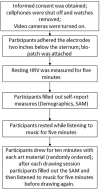Emotional Response and Changes in Heart Rate Variability Following Art-Making With Three Different Art Materials
- PMID: 29967587
- PMCID: PMC6015920
- DOI: 10.3389/fpsyg.2018.00968
Emotional Response and Changes in Heart Rate Variability Following Art-Making With Three Different Art Materials
Abstract
Art therapy encourages the use of art materials to express feelings and thoughts in a supportive environment. Art materials differ in fluidity and are postulated to thus differentially enhance emotional response (the more fluid the material the more emotion elicited). Yet, to the best of our knowledge, this assumption has not been empirically tested. The current study aimed to examine the emotional and physiological responses to art-making with different art materials. We were particularly interested in vagal activity, indexed by heart rate variability (HRV), because of its association with numerous health related outcomes. In this study, 50 adults (mean age 33 ± 10.27 years, 52% males) participated in a repeated measures experiment, in which they were requested to draw with three art materials (order randomized) differing in their level of fluidity (pencil, oil-pastels, and gouache paint) intermittent with periods of music. We measured the emotional response to art-making with each material using a self-report measure and matrices of HRV using a wearable electrocardiogram device. We calculated two indices of HRV, one indicative of parasympathetic nervous system (PNS) activity, and one indicative of sympathetic nervous system (SNS) activity. Art-making with gouache paint and oil-pastels resulted in improved positive mood, while pencil did not. Art-making explained approximately 35% of the variability in parasympathetic reactivity, which may indicate changes in emotional regulation processes during the art-making task. Yet, fluidity was not sufficient to explain the reaction to art-making. Surprisingly, the largest suppression of PNS and augmentation of the SNS occurred during art-making with oil-pastels and not with Gouache. Moreover, PNS and SNS reactivity to oil-pastels were related to emotional valance, which may point to emotional engagement. We can conclude that art-making with oil-pastels, first created in Japan in 1924 to increase self-expression of students, results in a unique emotional and physiological responses. These findings might be explained by the enhanced tactile experience of art-making with oil-pastels along with their relative fluidity, triggering an arousal pattern. Further studies that take the format and presentation of the materials as well as the content of the artwork, into account, are needed.
Keywords: art therapy; art-making; emotional response; expressive therapies continuum; heart rate variability.
Similar articles
-
Examining Changes in HRV and Emotion Following Artmaking with Three Different Art Materials.J Vis Exp. 2020 Jan 11;(155). doi: 10.3791/60376. J Vis Exp. 2020. PMID: 31984963
-
Dominant Parasympathetic Modulation of Heart Rate and Heart Rate Variability in a Wild-Caught Seabird.Physiol Biochem Zool. 2016 Jul-Aug;89(4):263-76. doi: 10.1086/686894. Epub 2016 May 11. Physiol Biochem Zool. 2016. PMID: 27327178
-
Heart rate variability reveals that a decrease in parasympathetic ('rest-and-digest') activity dominates autonomic stress responses in a free-living seabird.Comp Biochem Physiol A Mol Integr Physiol. 2017 Oct;212:117-126. doi: 10.1016/j.cbpa.2017.07.007. Epub 2017 Jul 23. Comp Biochem Physiol A Mol Integr Physiol. 2017. PMID: 28746844
-
[Heart rate variability. Applications in psychiatry].Encephale. 2009 Oct;35(5):423-8. doi: 10.1016/j.encep.2008.06.016. Epub 2008 Dec 18. Encephale. 2009. PMID: 19853714 Review. French.
-
Heart Rate Variability and Cardiac Vagal Tone in Psychophysiological Research - Recommendations for Experiment Planning, Data Analysis, and Data Reporting.Front Psychol. 2017 Feb 20;8:213. doi: 10.3389/fpsyg.2017.00213. eCollection 2017. Front Psychol. 2017. PMID: 28265249 Free PMC article. Review.
Cited by
-
Conceptualizing an antiracist framework for neuroscience research in art therapy: a qualitative pilot study.Front Hum Neurosci. 2025 Apr 23;19:1492779. doi: 10.3389/fnhum.2025.1492779. eCollection 2025. Front Hum Neurosci. 2025. PMID: 40337216 Free PMC article.
-
Cognitive and Physiological Measures in Well-Being Science: Limitations and Lessons.Front Psychol. 2019 Jul 12;10:1630. doi: 10.3389/fpsyg.2019.01630. eCollection 2019. Front Psychol. 2019. PMID: 31354601 Free PMC article.
-
A scoping review of integrated arts therapies and neuroscience research.Front Psychol. 2025 May 8;16:1569609. doi: 10.3389/fpsyg.2025.1569609. eCollection 2025. Front Psychol. 2025. PMID: 40406613 Free PMC article.
-
A conceptual framework for a neurophysiological basis of art therapy for PTSD.Front Hum Neurosci. 2024 Apr 22;18:1351757. doi: 10.3389/fnhum.2024.1351757. eCollection 2024. Front Hum Neurosci. 2024. PMID: 38711802 Free PMC article. Review.
-
Sensory-mediated "arts on prescription": emotional arousal mechanisms through Portuguese Azulejo craft workshop.Front Psychol. 2025 Jul 15;16:1595856. doi: 10.3389/fpsyg.2025.1595856. eCollection 2025. Front Psychol. 2025. PMID: 40735184 Free PMC article.
References
-
- Cohen A., Susser B. (2000). Israel and the Politics of Jewish identity: The Secular-Religious Impasse. Baltimore, MD: JHU Press.
LinkOut - more resources
Full Text Sources
Other Literature Sources


